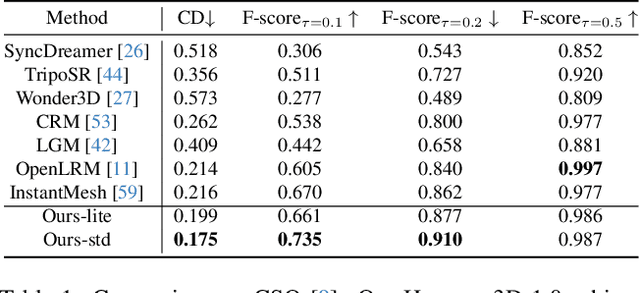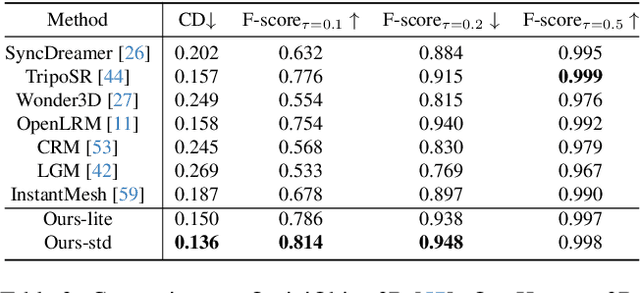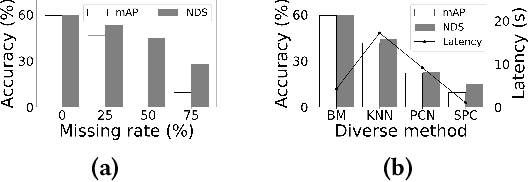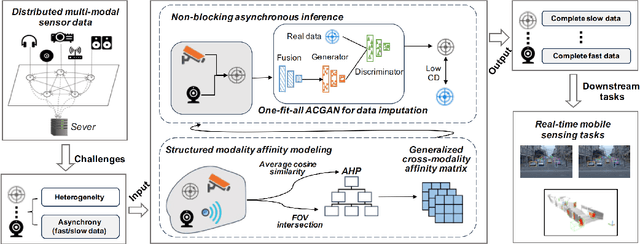Sicong Liu
refer to the report for detailed contributions
Learning Generalizable Skills from Offline Multi-Task Data for Multi-Agent Cooperation
Mar 27, 2025Abstract:Learning cooperative multi-agent policy from offline multi-task data that can generalize to unseen tasks with varying numbers of agents and targets is an attractive problem in many scenarios. Although aggregating general behavior patterns among multiple tasks as skills to improve policy transfer is a promising approach, two primary challenges hinder the further advancement of skill learning in offline multi-task MARL. Firstly, extracting general cooperative behaviors from various action sequences as common skills lacks bringing cooperative temporal knowledge into them. Secondly, existing works only involve common skills and can not adaptively choose independent knowledge as task-specific skills in each task for fine-grained action execution. To tackle these challenges, we propose Hierarchical and Separate Skill Discovery (HiSSD), a novel approach for generalizable offline multi-task MARL through skill learning. HiSSD leverages a hierarchical framework that jointly learns common and task-specific skills. The common skills learn cooperative temporal knowledge and enable in-sample exploitation for offline multi-task MARL. The task-specific skills represent the priors of each task and achieve a task-guided fine-grained action execution. To verify the advancement of our method, we conduct experiments on multi-agent MuJoCo and SMAC benchmarks. After training the policy using HiSSD on offline multi-task data, the empirical results show that HiSSD assigns effective cooperative behaviors and obtains superior performance in unseen tasks.
RALLRec+: Retrieval Augmented Large Language Model Recommendation with Reasoning
Mar 26, 2025Abstract:Large Language Models (LLMs) have been integrated into recommender systems to enhance user behavior comprehension. The Retrieval Augmented Generation (RAG) technique is further incorporated into these systems to retrieve more relevant items and improve system performance. However, existing RAG methods have two shortcomings. \textit{(i)} In the \textit{retrieval} stage, they rely primarily on textual semantics and often fail to incorporate the most relevant items, thus constraining system effectiveness. \textit{(ii)} In the \textit{generation} stage, they lack explicit chain-of-thought reasoning, further limiting their potential. In this paper, we propose Representation learning and \textbf{R}easoning empowered retrieval-\textbf{A}ugmented \textbf{L}arge \textbf{L}anguage model \textbf{Rec}ommendation (RALLRec+). Specifically, for the retrieval stage, we prompt LLMs to generate detailed item descriptions and perform joint representation learning, combining textual and collaborative signals extracted from the LLM and recommendation models, respectively. To account for the time-varying nature of user interests, we propose a simple yet effective reranking method to capture preference dynamics. For the generation phase, we first evaluate reasoning LLMs on recommendation tasks, uncovering valuable insights. Then we introduce knowledge-injected prompting and consistency-based merging approach to integrate reasoning LLMs with general-purpose LLMs, enhancing overall performance. Extensive experiments on three real world datasets validate our method's effectiveness.
SURGEON: Memory-Adaptive Fully Test-Time Adaptation via Dynamic Activation Sparsity
Mar 26, 2025Abstract:Despite the growing integration of deep models into mobile terminals, the accuracy of these models declines significantly due to various deployment interferences. Test-time adaptation (TTA) has emerged to improve the performance of deep models by adapting them to unlabeled target data online. Yet, the significant memory cost, particularly in resource-constrained terminals, impedes the effective deployment of most backward-propagation-based TTA methods. To tackle memory constraints, we introduce SURGEON, a method that substantially reduces memory cost while preserving comparable accuracy improvements during fully test-time adaptation (FTTA) without relying on specific network architectures or modifications to the original training procedure. Specifically, we propose a novel dynamic activation sparsity strategy that directly prunes activations at layer-specific dynamic ratios during adaptation, allowing for flexible control of learning ability and memory cost in a data-sensitive manner. Among this, two metrics, Gradient Importance and Layer Activation Memory, are considered to determine the layer-wise pruning ratios, reflecting accuracy contribution and memory efficiency, respectively. Experimentally, our method surpasses the baselines by not only reducing memory usage but also achieving superior accuracy, delivering SOTA performance across diverse datasets, architectures, and tasks.
CrowdHMTware: A Cross-level Co-adaptation Middleware for Context-aware Mobile DL Deployment
Mar 06, 2025Abstract:There are many deep learning (DL) powered mobile and wearable applications today continuously and unobtrusively sensing the ambient surroundings to enhance all aspects of human lives.To enable robust and private mobile sensing, DL models are often deployed locally on resource-constrained mobile devices using techniques such as model compression or offloading.However, existing methods, either front-end algorithm level (i.e. DL model compression/partitioning) or back-end scheduling level (i.e. operator/resource scheduling), cannot be locally online because they require offline retraining to ensure accuracy or rely on manually pre-defined strategies, struggle with dynamic adaptability.The primary challenge lies in feeding back runtime performance from the back-end level to the front-end level optimization decision. Moreover, the adaptive mobile DL model porting middleware with cross-level co-adaptation is less explored, particularly in mobile environments with diversity and dynamics. In response, we introduce CrowdHMTware, a dynamic context-adaptive DL model deployment middleware for heterogeneous mobile devices. It establishes an automated adaptation loop between cross-level functional components, i.e. elastic inference, scalable offloading, and model-adaptive engine, enhancing scalability and adaptability. Experiments with four typical tasks across 15 platforms and a real-world case study demonstrate that CrowdHMTware can effectively scale DL model, offloading, and engine actions across diverse platforms and tasks. It hides run-time system issues from developers, reducing the required developer expertise.
Hunyuan3D 2.0: Scaling Diffusion Models for High Resolution Textured 3D Assets Generation
Jan 21, 2025



Abstract:We present Hunyuan3D 2.0, an advanced large-scale 3D synthesis system for generating high-resolution textured 3D assets. This system includes two foundation components: a large-scale shape generation model -- Hunyuan3D-DiT, and a large-scale texture synthesis model -- Hunyuan3D-Paint. The shape generative model, built on a scalable flow-based diffusion transformer, aims to create geometry that properly aligns with a given condition image, laying a solid foundation for downstream applications. The texture synthesis model, benefiting from strong geometric and diffusion priors, produces high-resolution and vibrant texture maps for either generated or hand-crafted meshes. Furthermore, we build Hunyuan3D-Studio -- a versatile, user-friendly production platform that simplifies the re-creation process of 3D assets. It allows both professional and amateur users to manipulate or even animate their meshes efficiently. We systematically evaluate our models, showing that Hunyuan3D 2.0 outperforms previous state-of-the-art models, including the open-source models and closed-source models in geometry details, condition alignment, texture quality, and etc. Hunyuan3D 2.0 is publicly released in order to fill the gaps in the open-source 3D community for large-scale foundation generative models. The code and pre-trained weights of our models are available at: https://github.com/Tencent/Hunyuan3D-2
Fine-grained Spatio-temporal Event Prediction with Self-adaptive Anchor Graph
Jan 15, 2025Abstract:Event prediction tasks often handle spatio-temporal data distributed in a large spatial area. Different regions in the area exhibit different characteristics while having latent correlations. This spatial heterogeneity and correlations greatly affect the spatio-temporal distributions of event occurrences, which has not been addressed by state-of-the-art models. Learning spatial dependencies of events in a continuous space is challenging due to its fine granularity and a lack of prior knowledge. In this work, we propose a novel Graph Spatio-Temporal Point Process (GSTPP) model for fine-grained event prediction. It adopts an encoder-decoder architecture that jointly models the state dynamics of spatially localized regions using neural Ordinary Differential Equations (ODEs). The state evolution is built on the foundation of a novel Self-Adaptive Anchor Graph (SAAG) that captures spatial dependencies. By adaptively localizing the anchor nodes in the space and jointly constructing the correlation edges between them, the SAAG enhances the model's ability of learning complex spatial event patterns. The proposed GSTPP model greatly improves the accuracy of fine-grained event prediction. Extensive experimental results show that our method greatly improves the prediction accuracy over existing spatio-temporal event prediction approaches.
AdaScale: Dynamic Context-aware DNN Scaling via Automated Adaptation Loop on Mobile Devices
Dec 01, 2024Abstract:Deep learning is reshaping mobile applications, with a growing trend of deploying deep neural networks (DNNs) directly to mobile and embedded devices to address real-time performance and privacy. To accommodate local resource limitations, techniques like weight compression, convolution decomposition, and specialized layer architectures have been developed. However, the \textit{dynamic} and \textit{diverse} deployment contexts of mobile devices pose significant challenges. Adapting deep models to meet varied device-specific requirements for latency, accuracy, memory, and energy is labor-intensive. Additionally, changing processor states, fluctuating memory availability, and competing processes frequently necessitate model re-compression to preserve user experience. To address these issues, we introduce AdaScale, an elastic inference framework that automates the adaptation of deep models to dynamic contexts. AdaScale leverages a self-evolutionary model to streamline network creation, employs diverse compression operator combinations to reduce the search space and improve outcomes, and integrates a resource availability awareness block and performance profilers to establish an automated adaptation loop. Our experiments demonstrate that AdaScale significantly enhances accuracy by 5.09%, reduces training overhead by 66.89%, speeds up inference latency by 1.51 to 6.2 times, and lowers energy costs by 4.69 times.
Tencent Hunyuan3D-1.0: A Unified Framework for Text-to-3D and Image-to-3D Generation
Nov 05, 2024



Abstract:While 3D generative models have greatly improved artists' workflows, the existing diffusion models for 3D generation suffer from slow generation and poor generalization. To address this issue, we propose a two-stage approach named Hunyuan3D-1.0 including a lite version and a standard version, that both support text- and image-conditioned generation. In the first stage, we employ a multi-view diffusion model that efficiently generates multi-view RGB in approximately 4 seconds. These multi-view images capture rich details of the 3D asset from different viewpoints, relaxing the tasks from single-view to multi-view reconstruction. In the second stage, we introduce a feed-forward reconstruction model that rapidly and faithfully reconstructs the 3D asset given the generated multi-view images in approximately 7 seconds. The reconstruction network learns to handle noises and in-consistency introduced by the multi-view diffusion and leverages the available information from the condition image to efficiently recover the 3D structure. Our framework involves the text-to-image model, i.e., Hunyuan-DiT, making it a unified framework to support both text- and image-conditioned 3D generation. Our standard version has 3x more parameters than our lite and other existing model. Our Hunyuan3D-1.0 achieves an impressive balance between speed and quality, significantly reducing generation time while maintaining the quality and diversity of the produced assets.
AdaFlow: Opportunistic Inference on Asynchronous Mobile Data with Generalized Affinity Control
Oct 31, 2024



Abstract:The rise of mobile devices equipped with numerous sensors, such as LiDAR and cameras, has spurred the adoption of multi-modal deep intelligence for distributed sensing tasks, such as smart cabins and driving assistance. However, the arrival times of mobile sensory data vary due to modality size and network dynamics, which can lead to delays (if waiting for slower data) or accuracy decline (if inference proceeds without waiting). Moreover, the diversity and dynamic nature of mobile systems exacerbate this challenge. In response, we present a shift to \textit{opportunistic} inference for asynchronous distributed multi-modal data, enabling inference as soon as partial data arrives. While existing methods focus on optimizing modality consistency and complementarity, known as modal affinity, they lack a \textit{computational} approach to control this affinity in open-world mobile environments. AdaFlow pioneers the formulation of structured cross-modality affinity in mobile contexts using a hierarchical analysis-based normalized matrix. This approach accommodates the diversity and dynamics of modalities, generalizing across different types and numbers of inputs. Employing an affinity attention-based conditional GAN (ACGAN), AdaFlow facilitates flexible data imputation, adapting to various modalities and downstream tasks without retraining. Experiments show that AdaFlow significantly reduces inference latency by up to 79.9\% and enhances accuracy by up to 61.9\%, outperforming status quo approaches.
UbiHR: Resource-efficient Long-range Heart Rate Sensing on Ubiquitous Devices
Oct 25, 2024



Abstract:Ubiquitous on-device heart rate sensing is vital for high-stress individuals and chronic patients. Non-contact sensing, compared to contact-based tools, allows for natural user monitoring, potentially enabling more accurate and holistic data collection. However, in open and uncontrolled mobile environments, user movement and lighting introduce. Existing methods, such as curve-based or short-range deep learning recognition based on adjacent frames, strike the optimal balance between real-time performance and accuracy, especially under limited device resources. In this paper, we present UbiHR, a ubiquitous device-based heart rate sensing system. Key to UbiHR is a real-time long-range spatio-temporal model enabling noise-independent heart rate recognition and display on commodity mobile devices, along with a set of mechanisms for prompt and energy-efficient sampling and preprocessing. Diverse experiments and user studies involving four devices, four tasks, and 80 participants demonstrate UbiHR's superior performance, enhancing accuracy by up to 74.2\% and reducing latency by 51.2\%.
 Add to Chrome
Add to Chrome Add to Firefox
Add to Firefox Add to Edge
Add to Edge